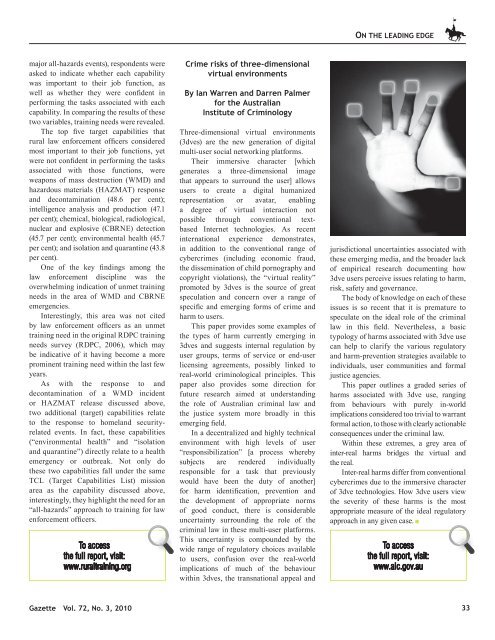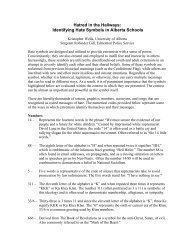RCMP Gazette Human Rights and Policing - Alberta Hate Crimes ...
RCMP Gazette Human Rights and Policing - Alberta Hate Crimes ...
RCMP Gazette Human Rights and Policing - Alberta Hate Crimes ...
You also want an ePaper? Increase the reach of your titles
YUMPU automatically turns print PDFs into web optimized ePapers that Google loves.
ON ThE lEADiNG EDGEmajor all-hazards events), respondents wereasked to indicate whether each capabilitywas important to their job function, aswell as whether they were confident inperforming the tasks associated with eachcapability. In comparing the results of thesetwo variables, training needs were revealed.The top five target capabilities thatrural law enforcement officers consideredmost important to their job functions, yetwere not confident in performing the tasksassociated with those functions, wereweapons of mass destruction (WMD) <strong>and</strong>hazardous materials (HAZMAT) response<strong>and</strong> decontamination (48.6 per cent);intelligence analysis <strong>and</strong> production (47.1per cent); chemical, biological, radiological,nuclear <strong>and</strong> explosive (CBRNE) detection(45.7 per cent); environmental health (45.7per cent); <strong>and</strong> isolation <strong>and</strong> quarantine (43.8per cent).One of the key findings among thelaw enforcement discipline was theoverwhelming indication of unmet trainingneeds in the area of WMD <strong>and</strong> CBRNEemergencies.Interestingly, this area was not citedby law enforcement officers as an unmettraining need in the original RDPC trainingneeds survey (RDPC, 2006), which maybe indicative of it having become a moreprominent training need within the last fewyears.As with the response to <strong>and</strong>decontamination of a WMD incidentor HAZMAT release discussed above,two additional (target) capabilities relateto the response to homel<strong>and</strong> securityrelatedevents. In fact, these capabilities(“environmental health” <strong>and</strong> “isolation<strong>and</strong> quarantine”) directly relate to a healthemergency or outbreak. Not only dothese two capabilities fall under the sameTCL (Target Capabilities List) missionarea as the capability discussed above,interestingly, they highlight the need for an“all-hazards” approach to training for lawenforcement officers.To accessthe full report, visit:www.ruraltraining.orgCrime risks of three-dimensionalvirtual environmentsby ian Warren <strong>and</strong> Darren Palmerfor the Australianinstitute of CriminologyThree-dimensional virtual environments(3dves) are the new generation of digitalmulti-user social networking platforms.Their immersive character [whichgenerates a three-dimensional imagethat appears to surround the user] allowsusers to create a digital humanizedrepresentation or avatar, enablinga degree of virtual interaction notpossible through conventional textbasedInternet technologies. As recentinternational experience demonstrates,in addition to the conventional range ofcybercrimes (including economic fraud,the dissemination of child pornography <strong>and</strong>copyright violations), the “virtual reality”promoted by 3dves is the source of greatspeculation <strong>and</strong> concern over a range ofspecific <strong>and</strong> emerging forms of crime <strong>and</strong>harm to users.This paper provides some examples ofthe types of harm currently emerging in3dves <strong>and</strong> suggests internal regulation byuser groups, terms of service or end-userlicensing agreements, possibly linked toreal-world criminological principles. Thispaper also provides some direction forfuture research aimed at underst<strong>and</strong>ingthe role of Australian criminal law <strong>and</strong>the justice system more broadly in thisemerging field.In a decentralized <strong>and</strong> highly technicalenvironment with high levels of user“responsibilization” [a process wherebysubjects are rendered individuallyresponsible for a task that previouslywould have been the duty of another]for harm identification, prevention <strong>and</strong>the development of appropriate normsof good conduct, there is considerableuncertainty surrounding the role of thecriminal law in these multi-user platforms.This uncertainty is compounded by thewide range of regulatory choices availableto users, confusion over the real-worldimplications of much of the behaviourwithin 3dves, the transnational appeal <strong>and</strong>jurisdictional uncertainties associated withthese emerging media, <strong>and</strong> the broader lackof empirical research documenting how3dve users perceive issues relating to harm,risk, safety <strong>and</strong> governance.The body of knowledge on each of theseissues is so recent that it is premature tospeculate on the ideal role of the criminallaw in this field. Nevertheless, a basictypology of harms associated with 3dve usecan help to clarify the various regulatory<strong>and</strong> harm-prevention strategies available toindividuals, user communities <strong>and</strong> formaljustice agencies.This paper outlines a graded series ofharms associated with 3dve use, rangingfrom behaviours with purely in-worldimplications considered too trivial to warrantformal action, to those with clearly actionableconsequences under the criminal law.Within these extremes, a grey area ofinter-real harms bridges the virtual <strong>and</strong>the real.Inter-real harms differ from conventionalcybercrimes due to the immersive characterof 3dve technologies. How 3dve users viewthe severity of these harms is the mostappropriate measure of the ideal regulatoryapproach in any given case. ▪To accessthe full report, visit:www.aic.gov.au<strong>Gazette</strong> Vol. 72, No. 3, 2010 33







